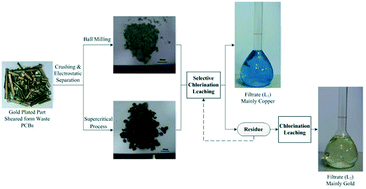Recycling gold and copper from waste printed circuit boards using chlorination process†
Abstract
Waste electric and electronic equipment (WEEE) usually contains many recoverable and valuable elements, including gold and copper. Primitive technologies, such as aqua regia leaching and calcination, are still widely used in China, which has caused serious pollution in local environments. Chlorination is a feasible alternative for the recovery of metallic elements due to the higher dissolution rate, non-polluting character and selective leaching of different metals by controlling the redox potential. In the present study, an efficient and less-polluted chlorination process to recycle gold and copper from waste PCBs was investigated. This work is based on a physical processing with a crush–pneumatic separation–corona electrostatic separation dealing with waste PCBs, which provided the raw material for chlorination process. The influence of different pretreatments and experimental parameters was studied. The result showed that more than 90% of copper could be selective recovered by controlling the Eh of leaching solution from 400 to 800 mV. The supercritical process had a better effect with a leaching yield of metallic elements over 99% percent, for both gold and copper. The ball milling process had different influence on gold and copper based on milling time. The leaching yield of copper increased with increase in ball-milling time. For gold, there was an optimal time around 10 min at 20 s−1 frequency of milling. The leaching yield of gold could reach more than 99% after a pretreatment with ball milling for 10 min when the leaching time was 90 min, the leaching temperature was 40 °C and the initial concentration of sulfuric acid was 100 g L−1. This study could contribute significantly to metallic element recycling of high value-added WEEE and provide technological parameters for industrial application in the future.


 Please wait while we load your content...
Please wait while we load your content...